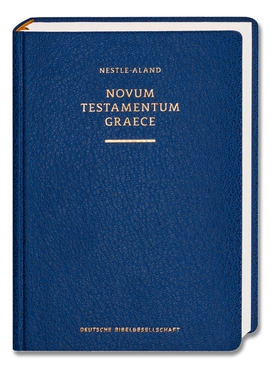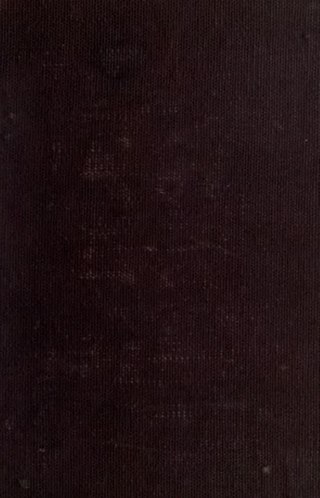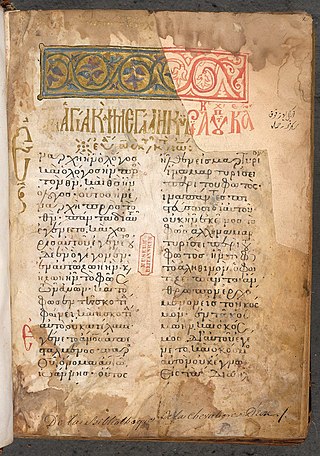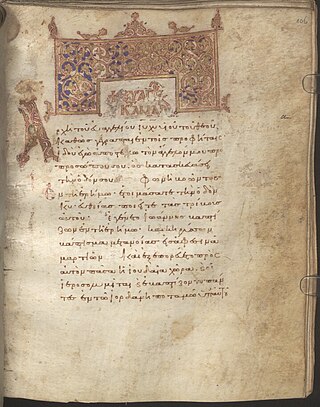Related Research Articles

Textual criticism is a branch of textual scholarship, philology, and literary criticism that is concerned with the identification of textual variants, or different versions, of either manuscripts (mss) or of printed books. Such texts may range in dates from the earliest writing in cuneiform, impressed on clay, for example, to multiple unpublished versions of a 21st-century author's work. Historically, scribes who were paid to copy documents may have been literate, but many were simply copyists, mimicking the shapes of letters without necessarily understanding what they meant. This means that unintentional alterations were common when copying manuscripts by hand. Intentional alterations may have been made as well, for example, the censoring of printed work for political, religious or cultural reasons.

Textus Receptus refers to the succession of printed editions of the Greek New Testament from Erasmus's Novum Instrumentum omne (1516) to the 1633 Elzevir edition.

The Codex Ephraemi Rescriptus designated by the siglum C or 04, δ 3, is a manuscript of the Greek Bible, written on parchment. It contains most of the New Testament and some Old Testament books, with sizeable portions missing. It is one of the four great uncials. The manuscript is not intact: its current condition contains material from every New Testament book except 2 Thessalonians and 2 John; however, only six books of the Greek Old Testament are represented. It is not known whether 2 Thessalonians and 2 John were excluded on purpose, or whether no fragment of either epistle happened to survive.

Novum Testamentum Graece is a critical edition of the New Testament in its original Koine Greek, forming the basis of most modern Bible translations and biblical criticism. It is also known as the Nestle–Aland edition after its most influential editors, Eberhard Nestle and Kurt Aland. The text, edited by the Institute for New Testament Textual Research, is currently in its 28th edition, abbreviated NA28.

The New Testament in the Original Greek is a Greek-language version of the New Testament published in 1881. It is also known as the Westcott and Hort text, after its editors Brooke Foss Westcott (1825–1901) and Fenton John Anthony Hort (1828–1892). Textual scholars use the abbreviations "WH" or "WHNU". It is a critical text, compiled from some of the oldest New Testament fragments and texts that had been discovered at the time.
New Testament manuscripts in Greek are categorized into five groups, according to a scheme introduced in 1981 by Kurt and Barbara Aland in The Text of the New Testament. The categories are based on how each manuscript relates to the various text-types. Generally speaking, earlier Alexandrian manuscripts are category I, while later Byzantine manuscripts are category V. Aland's method involved considering 1000 passages where the Byzantine text differs from non-Byzantine text. The Alands did not select their 1000 readings from all of the NT books; for example, none were drawn from Matthew and Luke.
A biblical manuscript is any handwritten copy of a portion of the text of the Bible. Biblical manuscripts vary in size from tiny scrolls containing individual verses of the Jewish scriptures to huge polyglot codices containing both the Hebrew Bible (Tanakh) and the New Testament, as well as extracanonical works.

Codex Basilensis, designated by Ee, 07 or ε 55, is a Greek uncial manuscript of the four Gospels, dated paleographically to the 8th century.

Codex Cyprius, designated by Ke or 017, ε71, or Codex Colbertinus 5149, is a Greek uncial manuscript of the four Gospels, written on parchment. It is one of the few uncial manuscripts with the complete text of the four Gospels, and it is one of the more important late uncial manuscripts. It was brought from Cyprus to Paris.

Codex Basiliensis A. N. IV. 1, known as Minuscule 2, ε 1214, is a Greek minuscule manuscript of the New Testament, written on vellum. Using the study of comparative writing styles (palaeography), it has been dated to the 11th or 12th century. The manuscript has complex contents.

Minuscule 4, ε 371, is a Greek minuscule manuscript of the New Testament, written on vellum. Using the study of comparative writing styles (palaeography), it has been dated to the 13th century. It was formerly named Codex Regius 84. It has a full collection of marginal marks. It was adapted for liturgical use.

Minuscule 5, δ 453, is a Greek minuscule manuscript of the New Testament, on 342 parchment leaves. Using the study of comparative writing styles (palaeography), it has been dated to the 13th century.
Minuscule 28, ε 168, formerly known as Colbertinus 4705, is a Greek minuscule manuscript of the New Testament, written on vellum. Using the study of comparative writing styles (palaeography), it has been dated to the 11th-century. It contains marginal notes (marginalia), and has several gaps.
Minuscule 346, ε 226, is a Greek minuscule manuscript of the New Testament, written on parchment. Using the study of comparative handwriting styles (palaeography) it has been assigned to the 12th century. It has notes in the margin.
Lectio brevior potior is one of the key principles in textual criticism, especially biblical textual criticism. The principle is based on the widely accepted view that scribes showed more tendency to embellish and harmonise by additions and inclusions than by deletions. Hence, when comparing two or more manuscripts of the same text, the shorter readings are considered more likely to be closer to the original.

Lectionary 184, designated by siglum ℓ184 is a Greek New Testament manuscript written on parchment. Textual critics Westcott and Hort referred to it by the siglum 39e, textual critic Scrivener by 259e. It is dated by a colophon to the year 1319. It is currently housed at the British Library in London.

Minuscule 652, ε1095, is a Greek minuscule manuscript of the New Testament, written on parchment. Using the study of comparative writing styles (palaeography), it has been assigned to the 10th century. The manuscript has complex contents, with "an interesting textual character". Biblical scholar Frederick H. A. Scrivener labelled it as 875.
Minuscule 918, O 66, is a 16th-century Greek minuscule manuscript of the New Testament on paper, with a commentary. The manuscript is famous for the Comma Johanneum.

Textual criticism of the New Testament is the identification of textual variants, or different versions of the New Testament, whose goals include identification of transcription errors, analysis of versions, and attempts to reconstruct the original text. Its main focus is studying the textual variants in the New Testament.
Maurice Arthur Robinson is an American professor of New Testament and Greek (retired) and a proponent of the Byzantine-priority method of New Testament textual criticism.
References
- ↑ Maurice A. Robinson, "New Testament Textual Criticism: The Case for Byzantine Priority", 2001.
- ↑ Tov, Emanuel (October 1982). "Criteria for Evaluating Textual Readings: The Limitations of Textual Rules". Harvard Theological Review . 75 (4): 429–448 esp. pp. 439ff. doi:10.1017/S0017816000031540. S2CID 165577319 . Retrieved 2012-12-16.
- ↑ Bentley, Jerry H. (1978). "Erasmus, Jean Le Clerc, and the Principle of the Harder Reading". Renaissance Quarterly. 31 (3): 309–321. doi:10.2307/2860228. ISSN 0034-4338.
- ↑ Page 117 in Trovato, P. (2014). Everything You Always Wanted to Know about Lachmann's Method. libreriauniversitaria.it.
- ↑ Noted in an observation by Frederick Henry Ambrose Scrivener in A Plain Introduction to the Criticism of the New testament (E. Miller, ed. 1894: vol. ii, p. 247) by W. L. Lorimer, "Lectio Difficilior", The Classical Review48.5 (November 1934:171).
- ↑ E.g. by H. J. Rose in The Classical Review48 (126, note 2), corrected by Lorimer 1934.
- ↑ Tov 1982:432.
- ↑ A. E. Housman, "The Application of Thought to Textual Criticism", Proceedings of the Classical Association18 (1922), pp. 67–84. DOI https://doi.org/10.5281/zenodo.8247611
- ↑ Robinson 2001
- ↑ Italics supplied. Bruce Metzger, The Text of the New Testament, II.i.1, p. 209.
- ↑ Aland, The Text of the New Testament, pp. 275–276; the Alands' twelve basic principles of textual criticism are reported on-line.
- ↑ Aland 1995, p. 276.
- ↑ West 1973, p. 51.